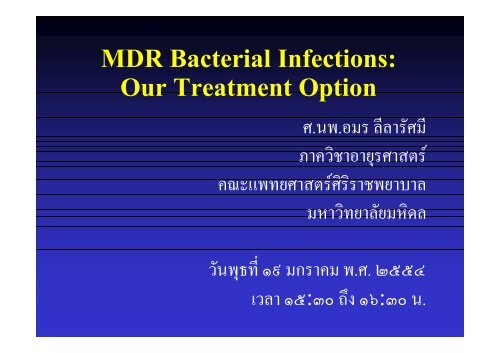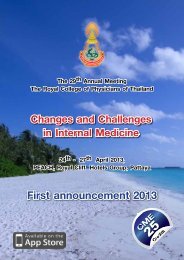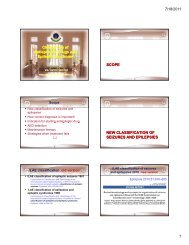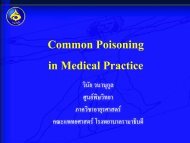MDR Bacterial Infections Our Treatment Option
MDR bacteria our treatment option RCPT Khon Kaen - นพ.อมร ลีลารัศมี
MDR bacteria our treatment option RCPT Khon Kaen - นพ.อมร ลีลารัศมี
Create successful ePaper yourself
Turn your PDF publications into a flip-book with our unique Google optimized e-Paper software.
<strong>MDR</strong> <strong>Bacterial</strong> <strong>Infections</strong>:<strong>Our</strong> <strong>Treatment</strong> <strong>Option</strong>ศ.นพ.อมร ลีลารัศมีภาควิชาอายุรศาสตรคณะแพทยศาสตรศิริราชพยาบาลมหาวิทยาลัยมหิดลวันพุธที่ ๑๙ มกราคม พ.ศ. ๒๕๕๔เวลา ๑๕:๓๐ ถึง ๑๖:๓๐ น.
Definition of <strong>MDR</strong>, XDR & PDR<strong>Bacterial</strong> PathogenMultiply drug resistant (<strong>MDR</strong>) bacteria• Resistant to antibiotics of at least three different classes ofantimicrobial agents used to treat the infections caused by thisbacteriaExtensively drug resistant (XDR) bacteria• Resistant to all antibiotics except only one class ofantimicrobial agent used to treat the infections caused by thisbacteria (e.g. susceptible to colistin only)Pan-drug resistant (PDR) bacteria• Resistant to antibiotics of all classes of antimicrobial agentsused to treat the infections caused by this bacteria
IDSA News: 10 New Antibiotics by 20201. Enterococcus faecium2. Staphylococcus aureus3. Klebsiella pneumoniae4. Enterobacter species5. Acinetobacter baumannii6. Pseudomonas aeruginosaVancomycin resistanceESBL/KPC/NDM-1AmpC productionXDR, PDR bacteria
SME-1, SME-2, SME-3
605040302010019111020107199920002617103421 22 22134215200120022003ESBL producing E. coli4415NARST dataUrine Blood Sputum492213482418200420052006(28 hospitals, 1998-2008)Ceftazidime%R %R4035302520151050%R2000132001ESBL by screen test16 17 192002200320042120052320062620075125202750302120072008200830sputumurineblood50454035302520151050%R706050403020100200019962020981999200020012426147ESBL by screen test2002Cefotaxime3629 2918920034221142001200220032004482415200420052006200732 33522418200559353020063736633420072008Urine Blood Sputum61413238200840sputumurineblood
504030201007060504030201001999312000200147.63834200033ESBL by screen test31 33 36 38 382002200320042005200648.641.6 44.2 47.443.842 42 4338 38353230ESBL producing K. pneumoniae200132200229 2820032004342005(28 hospitals, 1998-2008)Ceftazidime%R %R31200650.84035344020072008200746.14033200850.74332urinesputumblood8070605040302010070605040302010040 41 41 41 43 44 45 45 482000200163625442ESBL by screen test48 48 48404043Cefotaxime4120022003200420054351443954434753424820062007200856465546 45605044urinesputumbloodNARST dataUrine Blood SputumUrine Blood Sputum
Definition & Action of KPC, CRKP and CRECRE = carbapenem-resistant or carbapenemase-producingEnterobacteriaceaeCRKP = carbapenem-resistant Klebsiella pneumoniaeKPC = Klebsiella pneumoniae carbapenemaseThe organism can "Pop From one Strain to Another“The organism produces an enzyme that• degrades a very powerful antibiotic• confers low-level carbapenem resistance• is on a transferable genetic element• can pop from one strain to another and potentially fromone species to another and [be transmitted] from personto person and patient to patientKPCs display substantial carbapenem hydrolysis & is only weakly inhibited by clavulanic acid & tazobactamKPCs alone reduce susceptibility to carbapenems, they do not confer resistanceTo achieve full resistance to carbapenems, impaired outer-membrane permeability is often required
KPC-2–p K. pneumoniae in Greek HospitalsMaria Souli, Irene Galani, Anastasia Antoniadou. An Outbreak of Infection due to b-Lactamase Klebsiella pneumoniae Carbapenemase 2–Producing K. pneumoniae in a Greek University Hospital: Molecular Characterization, Epidemiology, and Outcomes. Clinical InfectiousDiseases 2010; 50:364–73.
Maria Souli, Irene Galani, Anastasia Antoniadou. An Outbreak of Infection due to b-Lactamase Klebsiella pneumoniae Carbapenemase 2–Producing K. pneumoniae in a Greek University Hospital: Molecular Characterization, Epidemiology, and Outcomes. Clinical InfectiousDiseases 2010; 50:364–73.
la NDM-1 positive Enterobacteria from Chennai 2009At Chennai, 2009; Enterobacteriaceae analyzed = 3,521• 4% found resistant to carbapenem(n=141)• E. coli 75• Klebsiella spp. 60• other Enterobacteriaceae 6• Of these 141 carbapenem-resistant Enterobacteriaceae,• 1.25 % were bla NDM-1 positive 44 (n=3,521)• E. coli 19• K. pneumoniae 14• Enterobacter cloacae 7• Proteus spp. 2• Citrobacter freundii 1• Klebsiella oxytoca 1www.thelancet.com/infection Published online August 11, 2010 DOI:10.1016/S1473-3099(10)70143-2
Antimicrobial Susceptibility for NDM-1–p Enterobacteriawww.thelancet.com/infection Published online August 11, 2010 DOI:10.1016/S1473-3099(10)70143-2
January 2007 - December 2008,50 patients whom KPC-2–producing K. pneumoniae were isolated• Admitted in the ICU (n=34)• Colonized (n=32)• Infected ( n=18)38 patients (76%) were identified after August 2008• Bacteremia 14• Surgical site infections 2• Lower respiratory tract infections 2 (1 bacteremic)• UTI 1Most patients received a colistin-containing combination Rx.Crude mortality Attributable mortality• Among ICU patients 58.8% 22.2%• Among non-ICU patients 37.5% 33.3%Maria Souli, Irene Galani, Anastasia Antoniadou. An Outbreak of Infection due to b-Lactamase Klebsiella pneumoniae Carbapenemase 2–Producing K. pneumoniae in a Greek University Hospital: Molecular Characterization, Epidemiology, and Outcomes. Clinical InfectiousDiseases 2010; 50:364–73.
KPC-p K. pneumoniaeisolate. (USA)Carbapenem-resistantK. pneumoniae due to- porin-loss- CTX-M-15 ESBL production- cephalosporinase hyperproductionModifiedHodge Testscreening test forcarbapenemaseproducingbacteria.KPC-p K. pneumoniaeisolate. (Greece)imipenem diskWild-type K. pneumoniaeisolateCarbapenemase GES-5-p E. cloacaeF = E coli DH10Bas lawn bacteriaKPCscreeningA susceptibleisolate of E. coliDH10B iscultured on aMueller-Hintonplate to create alawn of confluentgrowth
Cephalosporin & Aztreonam Breakpoints forEnterobacteriaceae by Year 2009 & 2010MIC breakpoints (μg/ml):Year 2010Agent Old (M100-S19) Revised (M100-S20)Susc Int Res Susc Int ResCefazolin ≤8 16 ≥32 ≤1 2 ≥4Cefotaxime ≤8 16-32 ≥64 ≤1 2 ≥4Ceftizoxime ≤8 16-32 ≥64 ≤1 2 ≥4Ceftriaxone ≤8 16-32 ≥64 ≤1 2 ≥4Ceftazidime ≤8 16 ≥32 ≤4 8 ≥16Aztreonam ≤8 16 ≥32 ≤4 8 ≥16CLSI M100-S20 (2010) Cephalosporin and Aztreonam Breakpoint Revisions. Fact Sheet
MIC distributions of NDM-1 Enterobacteriaamong Aminoglycoside including ACHN-490NDM-1 (17)MIC (mg/L)(no. isolates) ≤0.5 1 2 4 8 16 32 64 128 ≥256ACHN-490 1 1 5 10Amikacin 1 16Gentamicin 1 16Tobramycin 1 16Isepamicin 1 16Arbekacin 1 16Dibekacin 1 16Apramycin 9 8= resistant breakpoint by EUCASTLivermore DM, Mushtaq S, Warner M, Zhang JC, Maharjan S, Doumith M, Woodford N. Activity of aminoglycosides, includingACHN-490, against carbapenem-resistant Enterobacteriaceae isolates. J Antimicrob Chemother 2011;66:48–53.
MIC distributions of ACHN-490 amongCarbapenem-resistant EnterobacteriaceaeEnzymes producedMIC (mg/L)(no. isolates) ≤0.12 0.25 0.5 1 2 4 ≥64ACHN-490 (neoglycoside)• KPC (12) 1 5 6• SME-1 1• IMP (13) 1 9 3• NDM-1 (17) 1 16*• VIM (5) 3 1 1• OXA-48 (19) 1 17 1• ESBL+impermeability (10) 1 8 1• AmpC+impermeability (5) 3 2Livermore DM, Mushtaq S, Warner M, Zhang JC, Maharjan S, Doumith M, Woodford N. Activity of aminoglycosides, includingACHN-490, against carbapenem-resistant Enterobacteriaceae isolates. J Antimicrob Chemother 2011;66:48–53.
Drug of Choice for ESBL-producingEnterobacteriaCommunity-acquired infection• cSSSI• Diabetic infected ulcer• cIAI• Pyelonephritis• CAP due to Klebsiella spp.• Primary bacteremiaCarbapenem• Ertapenem• Imipenem• Meropenem• Doripenem• Biapenem
Antimicrobial Selection according to Risk ofInfection due to ESBL-producing EnterobacteriaEmpiric antibiotics by De-escalation MethodNo/Low risk of ESBLCeftriaxoneCeftazidimeCefepimePiperacillin-tazoMod./High risk of ESBLCarbapenem:ertapenemimipenemmeropenemdoripenem+Netilmicin/amikacin/levofloxacin/ ciprofloxacin/ Fosfomycin
Antimicrobial <strong>Option</strong> by Risk Level of ESBL-pLikelihood ofESBL-p EnterobacteriaCef: ceftriaxone, cefepime No risk or 0ceftazidimeCef + fosfomycin + , ++or + amikacin + ciprofloxacinErtapenem ± fosfomycin +, ++ ++++Imipenem, meropenem+++, ++++ & plusPseudomonas sp.,Acinetobacter sp.
Multidrug-resistant Gram-negative <strong>Infections</strong>:What Are the <strong>Treatment</strong> <strong>Option</strong>s?Drugs. 2009 Oct 1;69(14):1879-901.Multidrug-resistant Gram-negative infections: what are thetreatment options? Giamarellou H, Poulakou G.AbstractThe emergence of multidrug-resistant (<strong>MDR</strong>) Gram-negative bacillicreates a challenge in the treatment of nosocomial infections.While the pharmaceutical pipeline is waning,• Two revived old antibacterials (colistin and fosfomycin)• A newer one (tigecycline)• An 'improved' member of an existing class (doripenem)are the only therapeutic options left.
In vitro activities of fosfomycin and carbapenemcombinations against carbapenem non-susceptibleEscherichia coli and Klebsiella pneumoniaeDespite no synergy, MICs of these carbapenems were likelydecreased when + fosfomycin. (data not shown in the article)MICs (fold decreased when + fosfomycin)• Ertapenem 2.59• Imipenem 1.93• Meropenem 1.79• Doripenem 1.73MICs of fosfomycin were decreased ca. 1.89-foldOnly ertapenem MICs were significant decreased by StatisticsNetikul T, et al. In vitro activities of fosfomycin and carbapenem combinations against carbapenem nonsusceptibleEscherichia coli and Klebsiella pneumoniae. Int J Antimicrob Agents (2010), doi:10.1016/j.ijantimicag.2010.01.021
Effectiveness & Safety of Fosfomycin Rx inICU patients for CRKP <strong>Infections</strong>Daily dosage of intravenous fosfomycin• Administered via a central venous catheter1. In patients with normal renal function• daily dose 4 gm q 6 hours2. In elderly patients (>70 years)3. In patients with renal failure• daily dose 2 gm q 6 hours• In combination with other antibioticsSource of fosfomycin = All patients received Infectofos fl 2 gcontaining 2.64 g fosfomycin-sodium (InfectopharmArzneimittel und Consilium GmgH, Heppenheim, Germany)Michalopoulos A, Virtzili S, Rafailidis P, Chalevelakis G, Damala M, Falagas ME. Intravenous fosfomycin for the treatment of nosocomial infections causedby carbapenem-resistant Klebsiella pneumoniae in critically ill patients: A prospective evaluation. Clinical Microbiology and Infection 2010;16:184-6.
0.5, 1.0, 2.0-gm Human Simulated ProlongedInfusion of DoripenemPrevious animal studies have shown efficacy of a 500-mg dose ofdoripenem given as a 4-h infusion against P. aeruginosa withMICs of
Comparative efficacies of 1-g (black bars) and 2-g (white bars) dosesof doripenem against a distribution of P. aeruginosa isolates,presented as means ± the standard deviation.Asterisks indicate statistical significance (P 0.05). #, bacterialdensities were at the lower limit of detection.Crandon JL et al. AAC 2009;53:4352-6.
FIC Index & InterpretationInterpretation 3 combo 2 comboSynergy (S) < 1.0 ≤ 0.5Partial synergy (PS) - > 0.5 to < 1Additive (Ad) 1.0 1Indifference (I) - >1 to < 4Antagonist (An) > 1 ≥ 42 combo = meropenem + colistin3 combo = meropenem + colistin + fosfomycin (87.3 mg/L)
MICs of 5 <strong>MDR</strong> P. aeruginosa IsolatesStrain Fosfomycin Meropenem Colistin1 > 256 16 22 256 16 23 > 256 16 24 > 256 32 25 > 256 32 2Fosfo = fosfomycin; Mero = meropenem;
FIC Index of <strong>MDR</strong> P. aeruginosaStrain no. 3 combo 2 combo1 0.0456 (S) 1.0 (A)2 0.0675 (S) 0.503 (PS)3 0.0756 (S) 1.03 (I)4 0.0378 (S) 0.75 (PS)5 0.2578 (S) 0.75 (PS)2 combo = meropenem + colistin3 combo = meropenem + colistin + fosfomycin (87.3 mg/L)
Pintip Pongpech, Suparak Amornnopparattanakul, Sakulthip Panapakdee, Siriporn Fungwithaya, Penphun Nannha, Chertsak Dhiraputra, Amorn Leelarasamee.Antibacterial activity of carbapenem-based combinations against multidrug-resistant Acinetobacter baumannii. J Med Assoc Thai 2010;93:161-71.
Population PharmacokineticAnalysis of CMS & Colistin afterIV Administration in Critically IllPatientsNormal renal functionPlachouras D, Karvanen M, Friberg LE, et al. Populationpharmacokinetic analysis of colistin methanesulfonate andcolistin after intravenous administration in critically illpatients with infections caused by gram-negative bacteria.Antimicrob Agents Chemother 2009;53:3430–6
Model-predicted CMS & Colistin Concentrations inCritically Ill PatientsCurrent dosing regimen of CMS in a typical patient1. 3 MU (240 mg of CMS)2. A 15-min infusion3. every 8 hours [q8h])Alternative dosing regimens with1. Loading doses of1.1 9 MU CMS (720 mg. of CMS)1.2 or 12 MU CMS (960 mg of CMS)2. Duration of infusions2.1 15 min2.2 or 2 h3. A maintenance dose of• 4.5 MU (360 mg) CMS• Every 12 h (q12h)Plachouras D, Karvanen M, Friberg LE, et al. Population pharmacokinetic analysis of colistin methanesulfonate and colistin after intravenous administration incritically ill patients with infections caused by gram-negative bacteria. Antimicrob Agents Chemother 2009;53:3430–6
Attenuation of Colistin Bactericidal Activity byHigh Inoculum of Pseudomonas aeruginosaIn vitro time-kill experiments using 8-64 x the MIC of colistinP. aeruginosa PAO1 at initial CFUo of 10 6 , 10 8 , and 10 9 CFU/ml.Against PAO Killing rate of the susceptible population- at the 10 9 CFUo 23-fold slower- at the 10 8 CFUo 6-fold slower- at the 10 6 CFUo 1-fold (for comparison)Bacteria were assumed to release signal molecules stimulating aphenotypic change that inhibits killing.The extent and rate of killing of P. aeruginosa were markedlydecreased at high CFUo compared to those at low CFUo.Bulitta JB, Yang JC, Yohonn L, Ly NS, Brown SV, D'Hondt RE, et al. Attenuation of colistin bactericidal activity by high inoculum of Pseudomonasaeruginosa characterized by a new mechanism-based population pharmacodynamic model. Antimicrob Agents Chemother 2010;54:2051-62.
Pharmacokinetic/Pharmacodynamic Determinant of ColistinActivity against Pseudomonas aeruginosaColistin is increasingly used as last-line therapy against Gramnegativepathogens. The pharmacokinetic/pharmacodynamic(PK/PD) index best correlating with efficacy of colistin remainsundefined.The PK/PD of colistin was studied in neutropenic mouse thigh andlung infection models against three strains of Pseudomonasaeruginosa.The PK/PD index that correlated best with its efficacy wasfAUC/MIC in both thigh (R 2 = 87%) and lung (R 2 = 89%)infection models.Dudhani RV, Turnidge JD, Coulthard K, Milne RW, Rayner CR, Li J, Nation RL. Elucidation of pharmacokinetic/pharmacodynamic determinant ofcolistin activity against Pseudomonas aeruginosa in murine thigh and lung infection models. Antimicrob Agents Chemother 2010;54(3):1117-24
Pharmacokinetic/Pharmacodynamic Determinant of ColistinActivity against Pseudomonas aeruginosaThe fAUC/MIC targetsRequired to achieve kill against the three strains1-log kill 2-log killNeutropenic rat model- The thigh infection model 15.6 - 22.8 27.6 - 36.1- The lung infection model 12.2 - 16.7 36.9 - 45.9This in vivo study indicated the importance of achieving adequatetime-averaged exposure to colistinThe results will facilitate efforts to define more rational design ofdosage regimens in humans.Dudhani RV, Turnidge JD, Coulthard K, Milne RW, Rayner CR, Li J, Nation RL. Elucidation of pharmacokinetic/pharmacodynamic determinant ofcolistin activity against Pseudomonas aeruginosa in murine thigh and lung infection models. Antimicrob Agents Chemother 2010;54(3):1117-24
Recommended Definite Therapy for Serious <strong>Infections</strong> Causedby Drug-resistant Gram-negative BacteriaExtended-spectrum β-lactamase–producing Enterobacteriaceae• Meropenem 1–2 g IV q 8 hr• Imipenem 500 mg IV q 6 h• Doripenem 500 mg IV q 8 hr or as a 1-hr or 4-hr infusionCarbapenemase-producing Enterobacteriaceae• Colistin 2.5-5.0 mg of colistin base/kg of BW/day q 6-12 h• (equivalent to 6.67–13.3 mg of colistimethate sodium/kg /day);• Tigecycline 100 mg IV as a loading dose, then 50 mg IV q 12 hCarbapenem-resistant P. aeruginosa• Colistin as for carbapenemase-producing EnterobacteriaceaePossible alternatives• Extended infusion of carbapenemPeleg AY, Hooper DC. Hospital-Acquired <strong>Infections</strong> Due to Gram-Negative Bacteria . N Engl J Med 2010;362:1804-13.
Recommended Definite Therapy for Serious <strong>Infections</strong> Causedby Drug-resistant Gram-negative BacteriaCarbapenem-resistant A. baumannii• Colistin as for carbapenemase-producing Enterobacteriaceae• Ampicillin-sulbactam, up to 6 g of sulbactam IV per day• Tigecycline 100-mg IV loading dose, then 50 mg IV q 12 h‡‡ This regimen would not be recommended for bloodstream infection, owing to low serum drug levels.Possible alternativesExtended infusion of carbapenem• Meropenem 1-2 g IV infusion over a 3-hr period every 8 hr• Doripenem, 500 mg- 1 g IV infusion over a 4-hr period q 8 hr• Imipenem 1 g IV infusion over a 3-hr period q 8 hCombination therapy with a nontraditional antibiotic § , including• Rifampin• Minocycline• Azithromycin• Doxycycline§Use of these antibiotics is based on in vitro data and animal models and on clinical case reports and studies of small series of patients.Peleg AY, Hooper DC. Hospital-Acquired <strong>Infections</strong> Due to Gram-Negative Bacteria . N Engl J Med 2010;362:1804-13.
Therapeutic Efficacy of Vancomycin in Relationto MIC or Bactericidal ActivityVancomycin Therapy in MRSA BacteremiaSuccess rate % Success rate %10010080604056%20 n = 910%0n =21≤ 0.5 1.0-2.0Vancomycin (MIC, ug/ml)P value < 0.0580P value < 0.056050%40200Exposure of MRSA 10 7 to 10 8 CFU/ml tovancomycin (16 µg/ml) for 72 hr.n = 90%23%n = 13n = 86.26Log 10 of Killing (CFU/ml)Sakoulas G, Moise-Broder PA, Schentag J, Forrest A, Moellering RC Jr, Eliopoulos GM. Relationship of MIC and bactericidal activity toefficacy of vancomycin for treatment of methicillin-resistant Staphylococcus aureus bacteremia J Clin Microbiol 2004;42:2398-402.
Breakpoint Criteria of Vancomycin for S. aureusFor vancomycin susceptibility testing: needs MICMIC ResultCLSI prior to CLSI after EUCAST2006 (g/ml) 2006 (g/ml) (g/ml)Susceptible (VSSA) ≤4 ≤2 ≤2Intermediate (VISA) 8-16 4-8 -Resistant (VRSA) ≥32 ≥16 ≤4The breakpoints for other infectious agent remain unchanged.
These simulations assumed a vancomycinclearance of 4.7 L/h, with a coefficient of variationof 43% and a dosage regimen of 1 g every 12hours. The pharmacodynamic target was a 24-hourAUC/MIC ratio of 300 because target AUC/MICratios of 200 to 400 have been reported in studieswith vancomycin.Staphylococcus aureusComparison of simulated target attainment profiles for dalbavancin (AUC 14 days /MIC > 1000)and vancomycin (AUC/ MIC > 300) for Staphylococcus aureusJames A. Dowell, et al. Pharmacokinetic-Pharmacodynamic Modeling of Dalbavancin, a Novel Glycopeptide Antibiotic. J Clin Pharmacol 2008;48:1063-8.
One Gram bid: Enough for Vancomycin?Conclusions:1. Parameter best predicts vancomycin efficacy is AUC/MIC(= 400 mg.h/L is adequate for MRSA MIC ≤ 0.5 mg/L)2. No relationship between Time>MIC and response3. Trough serum conc. can be used as surrogate measure of AUC(optimal trough level 15-20 mg/L)4. 1 gm q 12 h is suboptimal for 80 kg patient with normal renalfunction (AUC/MIC = 250 mg.h/L) for MRSA MIC > 1 mg/L5. A daily dose of 3-4 gm. required for 100 & 90% target attainment(AUC/MIC = 400) for a MIC S. aureus = 0.5 & 1 mg/L respectively6. Mean trough level = 20 mg/L AUC/MIC = 418 mg.h/L7. If MIC S. aureus = 2 mg/L, probability of target attainment = 0Rybak M, Lomaestro B, Rotschafer JC, Moellering R, Craig W, Billeter M, et al. Therapeutic monitoring of vancomycin in adult patients: A consensus review of the American Society of Health-System Pharmacists, the Infectious Diseases Society of America, and the Society of Infectious Diseases Pharmacists. Am J Health Syst Pharm 2009;66(1):82-98.
การใชยา vancomycin ในการรักษาโรคติดเชื้อ MRSAการใชยาบางขนานมีความจําเพาะกับเชื้อกอโรค ขนาดยาที่ใชตองเหมาะสมกับสภาพของโรคติดเชื้อและมีการตรวจหาคา MIC และระดับยาดวย เชน การใชยา vancomycin ในการรักษาโรคติดเชื้อ MRSA• ขนาดของยา vancomycin ในผูใหญคือ 15–20 มก./กก. /ครั้ง• ใหใชน้ําหนักตัวที่ชั่งได (actual body weight)• ใหยาทุก 8–12 ชั่วโมง• ใหไมเกินครั้งละ 2 กรัมในผูปวยที่มีหนาที่ไตปกติ• ในรายที่ปวยรุนแรง เชน sepsis, meningitis, pneumonia, infective endocarditis แนะนําให loading dose ขนาด 25–30 มก./กก. (actual body weight) ในการใหยาครั้งแรก• ถาขนาดยามากกวา 1 กรัมตอครั้ง อาจจะหยดยานาน 1-2 ชั่วโมง และฉีดยา antihistamineกอนจะให loading dose ไดLiu C, Bayer A, Cosgrove SE, Daum RS, Fridkin SK, Gorwitz RJ, et al. Clinical practice guidelines by the Infectious Diseases Society of America for the <strong>Treatment</strong> of methicillin-resistantStaphylococcus aureus infections in adults and children. Clin Infect Dis 2011;52:1–38
การใชยา vancomycin ในการรักษาโรคติดเชื้อ MRSAการใชยาบางขนานมีความจําเพาะกับเชื้อกอโรค ขนาดยาที่ใชตองเหมาะสมกับสภาพของโรคติดเชื้อและมีการตรวจหาคา MIC และระดับยาดวย เชน การใชยา vancomycin ในการรักษาโรคติดเชื้อ MRSA• ควรวัดระดับยาในระยะ trough concentration ในระยะ steady state เชน วัดระดับยากอนจะใหยาครั้งที่ 4 หรือ 5 เปนตน• ระดับยาในระยะ trough concentration ควรอยูที่ 15-20 ไมโครกรัมตอ มล. ในการรักษาโรคติดเชื้อ MRSA ที่รุนแรง เชน sepsis, infective endocarditis, osteomyelitis, meningitis,pneumonia, necrotizing fasciitis• สวนในรายที่ไมอวน และหนาที่ไตปกติ และติดเชื้อไมรุนแรงหรือไมถึงกับ sepsis ใชยาvancomycin ขนาด 1 กรัม ทุก 12 ชั่วโมงไดและไมตองวัดหา trough concentration• ไมแนะนําใหหยดยาขนานนี้แบบตอเนื่องนาน 24 ชั่วโมงLiu C, Bayer A, Cosgrove SE, Daum RS, Fridkin SK, Gorwitz RJ, et al. Clinical practice guidelines by the Infectious Diseases Society of America for the <strong>Treatment</strong> of methicillin-resistantStaphylococcus aureus infections in adults and children. Clin Infect Dis 2011;52:1–38
ความไวของเชื้อ MRSA กับยา vancomycinการเลือกใชยา vancomycin ตามความไวของเชื้อ MRSA ตอยา vancomycin• ถาเชื้อ MRSA มีคา MIC ตอยา vancomycin เทากับ 2 ไมโครกรัมตอ มล. หรือ นอยกวาหากผูปวยตอบสนองตอการรักษาดวย empiric vancomycin ก็ใหยา vancomycin ในขนาดเดิมตอไปและติดตามผลการรักษาตอไปอยางใกลชิด• ถาลักษณะคลินิกไมตอบสนองตอยาแมวา ทําการระบายหนองหรือตัดเนื้อตายทิ้งแลวควรใชยาขนานอื่นแทน vancomycin เลยแมวาเชื้อจะมีคา MIC ตอ vancomycin ในระดับที่ต่ํากวา 2 ไมโครกรัมตอ มล. ก็ตาม• ถาเชื้อ MRSA มีคา MIC ตอยา vancomycin มากกวา 2 ไมโครกรัมตอ มล. (เชน เชื้อ VISAหรือ VRSA) ใหเลือกใชยาขนานอื่นแทน vancomycinLiu C, Bayer A, Cosgrove SE, Daum RS, Fridkin SK, Gorwitz RJ, et al. Clinical practice guidelines by the Infectious Diseases Society of America for the <strong>Treatment</strong> of methicillin-resistantStaphylococcus aureus infections in adults and children. Clin Infect Dis 2011;52:1–38
ยาขนานอื่น ถาเชื้อ MRSA ไมไวตอยา vancomycinถาโรคติดเชื้อ MRSA ไมตอบสนองตอยา vancomycin และยังคงมี MRSA bacteremiaแนะนําใหกําจัดแหลงติดเชื้อหรือระบายหนองออก ถอดเอาสิ่งแปลกปลอมหรือสายสวนที่ติดเชื้อออก แลวพิจารณาใหยาดังตอไปนี้• ยา daptomycin ขนาด 10 มก./กก./วัน + ยาขนานใดขนานหนึ่ง ดังตอไปนี้• ยา gentamicin ขนาด 1 มก./กก. หยดเขาทางหลอดเลือดดําทุก 8 ชั่วโมง• ยา rifampin ขนาด 600 มก. กินหรือฉีด วันละครั้ง หรือขนาด 300-450 มก. กินหรือฉีดวันละ 2 ครั้ง• ยา linezolid ขนาด 600 มก. กินหรือหยดเขาหลอดเลือดดํา 30-60 นาที วันละ 2 ครั้ง• ยา TMP-SMX ขนาด 5 มก./กก. หยดเขาหลอดเลือดดําวันละ 2 ครั้ง• อาจจะพิจารณาใชยากลุม beta-lactam รวมดวยLiu C, Bayer A, Cosgrove SE, Daum RS, Fridkin SK, Gorwitz RJ, et al. Clinical practice guidelines by the Infectious Diseases Society of America for the <strong>Treatment</strong> of methicillin-resistantStaphylococcus aureus infections in adults and children. Clin Infect Dis 2011;52:1–38
ยาขนานอื่น ถาเชื้อ MRSA ไมไวตอยา vancomycinถาโรคติดเชื้อ MRSA ไมตอบสนองตอยา vancomycin และยังคงมี MRSA bacteremiaแนะนําใหกําจัดแหลงติดเชื้อหรือระบายหนองออก ถอดเอาสิ่งแปลกปลอมหรือสายสวนที่ติดเชื้อออก แลวพิจารณาใหยาดังตอไปนี้หากเชื้อไมไวตอ vancomycin และ daptomycin ใหเลือกใชยาขนานใดขนานหนึ่ง หรือใชยารวมกันดังนี้• ยา quinupristin/dalfopristin ขนาด 7.5 มก./กก/ครั้ง หยดเขาหลอดเลือดดําทุก 8 ชั่วโมง• ยา TMP-SMX ขนาด 5 มก./กก./ครั้ง หยดเขาหลอดเลือดดําวันละ 2 ครั้ง• ยา linezolid ขนาด 600 มก. กินหรือหยดเขาหลอดเลือดดํานาน 30-60 นาที วันละ 2 ครั้ง• ยา telavancin ขนาด 10 มก./กก./ครั้งหยดเขาหลอดเลือดดํา วันละ 1 ครั้งในประสบการณของผูเขียนเอง ในผูใหญอาจจะเลือกใชยา fosfomycin ขนาด 2-4 กรัมหยดเขาหลอดเลือดดํานาน 60 นาที ทุก 8 ชั่วโมง นาจะไดผลดี อาจจะใหรวมกับยาขนานอื่นๆ ก็ไดLiu C, Bayer A, Cosgrove SE, Daum RS, Fridkin SK, Gorwitz RJ, et al. Clinical practice guidelines by the Infectious Diseases Society of America for the <strong>Treatment</strong> of methicillin-resistantStaphylococcus aureus infections in adults and children. Clin Infect Dis 2011;52:1–38
Early Combination Rx vs. Monotherapyin Septic ShockSeptic shock in the ICU represents• The major cause of infection-associated mortalityThe possibility that combination antibiotic therapy of bacterialseptic shock improves outcome• Is controversialCurrent guidelines do NOT recommend combination therapy• Except for the express purpose of broadening coveragewhen resistant pathogens are a concern.Kumar A, Zarychanski R, Light B, Parrillo J, Maki D, Simon D, Laporta D, et al. Early combination antibiotic therapy yields improvedsurvival compared with monotherapy in septic shock: a propensity-matched analysis. Crit Care Med 2010;38:1773-85.
Early Combination Rx vs. Monotherapyin Septic ShockIn patients with bacterial septic shock, to evaluate the benefit of• Early combination therapy• Comprising at least two antibiotics• of different mechanisms• with in vitro activity for the isolated pathogenDESIGNRetrospective, propensity matched, multicenter, cohort study.ICUs of 28 academic and community hospitals in threecountries between 1996 and 2007.Kumar A, Zarychanski R, Light B, Parrillo J, Maki D, Simon D, Laporta D, et al. Early combination antibiotic therapy yields improvedsurvival compared with monotherapy in septic shock: a propensity-matched analysis. Crit Care Med 2010;38:1773-85.
Early Combination Rx vs. Monotherapyin Septic ShockA total of 4,662 eligible cases of culture-positive, bacterialseptic shock treated with combination or monotherapy fromwhich 1223 propensity-matched pairs were generated.The primary outcome of study was 28-day mortality.Using a Cox proportional hazards model,Combination Rx MonoRx• 28-day mortality 355/1223 (29%) 444/1223 (36.3%)• Hazard ratio 0.77• 95% CI 0.67-0.88 (p = 0.0002)Kumar A, Zarychanski R, Light B, Parrillo J, Maki D, Simon D, Laporta D, et al. Early combination antibiotic therapy yields improvedsurvival compared with monotherapy in septic shock: a propensity-matched analysis. Crit Care Med 2010;38:1773-85.
Early Combination Rx vs. Monotherapyin Septic ShockThe beneficial impact of combination therapy applied to• Gram-positive infection• Gram-negative infection• BUT was restricted to patients treated with• Beta-lactams in combination with (either one)1. Aminoglycosides2. Fluoroquinolones3. Macrolides/clindamycinKumar A, Zarychanski R, Light B, Parrillo J, Maki D, Simon D, Laporta D, et al. Early combination antibiotic therapy yields improvedsurvival compared with monotherapy in septic shock: a propensity-matched analysis. Crit Care Med 2010;38:1773-85.
Early Combination Rx vs. Monotherapyin Septic ShockCombination Rx MonoRx• ICU admission 352/1,223 (28.8%) 437/1,223 (35.7%)• Odds ratio 0.75• 95% CI 0.63-0.92 (p = .0006)• Hospital mortality 457/1,223 (37.4%) 584/1,223 (47.8%)• Odds ratio 0.69• 95% CI 0.59-0.81 (p < .0001)Kumar A, Zarychanski R, Light B, Parrillo J, Maki D, Simon D, Laporta D, et al. Early combination antibiotic therapy yields improvedsurvival compared with monotherapy in septic shock: a propensity-matched analysis. Crit Care Med 2010;38:1773-85.
Early Combination Rx vs. MonotherapyCombination Rx MonoRxVentilator-free day• Median 17 10• Interquartile range 0-26 0-25 (p = .008)Pressor/inotrope-free day• Median 25 23• Interquartile range 0-28 0-28 (p = .007)up to 30 daysEarly combination antibiotic therapy is associated with decreasedmortality in septic shockProspective randomized trials are neededin Septic ShockKumar A, Zarychanski R, Light B, Parrillo J, Maki D, Simon D, Laporta D, et al. Early combination antibiotic therapy yields improvedsurvival compared with monotherapy in septic shock: a propensity-matched analysis. Crit Care Med 2010;38:1773-85.
Thank youAny Comment?Any Question?







